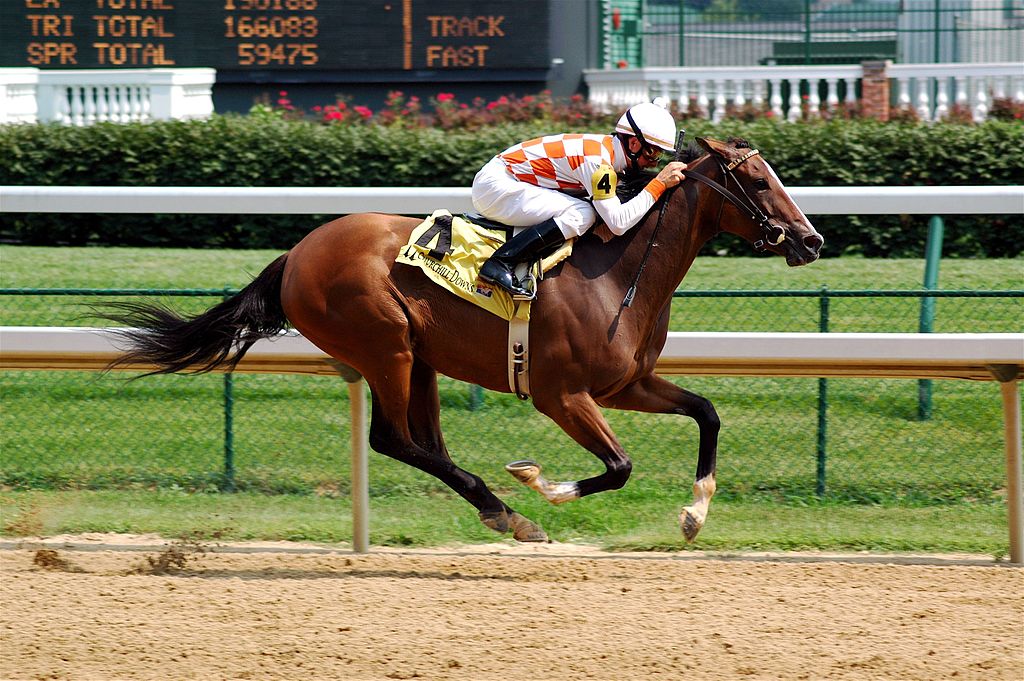The English Thoroughbred
The English Thoroughbred, Racehorse or Thoroughbred, selected for its aptitude for speed, has become the fastest horse in the world and dominates racing. As early as the end of the 11th century, the English king William I the Conqueror introduced Spanish horses. In the 14th century, Arabian horses began to be imported as the English began to develop a passion for horse racing. By the 15th century, under the reign of Henry VIII, stud farms were already creating racehorses by crossing Irish (Hobby), Scottish (Galloway), Andalusian and Italian (Neapolitan) horses with Turks, Arabs, and Barbarians.

In the 17th century, racing became an institution. The contribution of Arabian, Turkish and Barb stallions became widespread under the reigns of James I and Charles II. Cromwell bought a Turkish stallion, The White Turk.
At the beginning of the 18th century, the definitive constitution of the English Thoroughbred was achieved through the selection of England’s best racing mares (Royal Mares), who were united with three remarkable sires:
- Byerley Turk, Darley Arabian and Godolphin Arabian.
- Byerley Turk, bought in 1690, of oriental origin (a Turkmen?), type of desert horse, bay.
- Darley Arabian, Arabian horse, born in 1702 in Syria, purchased around 1710.
- Godolphin Arabian, certainly a Barbe, born in 1724, offered to Louis XV who disposed of it. He was found in Paris and bought by Lord Godolphin for his stud.
The result was Lath, a remarkable racehorse.
These three sires were crossed with the “royal mares” to produce three bloodlines:
- Matchem, bay, born in 1748, descended from 2L generation Godolphin;
- Herod, born in 1758, with predominant Byerley blood. Herold in turn sired Highflyer, the fourth head of the Thoroughbred line;
- Eclipse, chestnut, born 1764; fourth-generation descendant of Darley Arabian, unbeaten phenomenon, the best and perhaps the most beautiful Thoroughbred horse ever.
Eclipse’s descendants were by far the most numerous.
All current Thoroughbreds are descendants of these lineage leaders. The aim of obtaining speed was perfectly achieved, since speed was brought to the most extreme degree by the selection of lanky horses that became ultra-lanky. The English Stud Book, the oldest register of origins, was instituted in 1791.
In France, a few races took place before the Revolution and were resumed in 1806 under the control of the Administration of stud farms. The English Thoroughbred appeared under the Restoration. The French Stud Book was created in 1833. The breeding of the Thoroughbred, which became international, contributed to the improvement of numerous breeds, just as the Arabian did in its day. g to take just one example, let’s mention the creation of the Anglo-Arabian, an excellent sport horse.
Caractère et aptitudes du cheval
Sometimes delicate in character, but generous and courageous, these horses are vigorous, with lively reactions and reflexes. Extremely ardent, it has a lot of “blood”, i.e., nerve impulses. It is the fastest horse in the world. Its speed can exceed 70 km/hour. Its strides are wide and sweeping.
Utilisations du cheval
This horse is used for flat racing and galloping obstacle courses. In flat racing, we distinguish the “Sprinter”, a specialist over 1,000 m; the “Miler”, a 1,600 m horse; the “Classic” over 2,400 m and the “Stayer” over longer distances. It also shows great aptitude for eventing. In addition, it is still used to improve many breeds.
Morphologie du cheval
Extremely racy, long, and athletic. Very harmonious, exuding nobility. Head lean, light, chiseled, longer and stronger than that of the Arab. Profile rather rectilinear, very rarely cambered. Broad forehead. Thin lips. Wide nostrils with fine wings. Ears a little long but fine. Large eyes. Slender, streamlined body. Fine, long neck. Long, prominent withers. Long, sloping shoulders. Narrow fore chest. Ample, deep, ogival chest. Back straight, short, strong. Short, well-muscled loins. Powerful hindquarters. Horizontal, long croup. Limbs long, dry, and wet, sometimes light but well jointed. Tendons dry. Long forearms. Short cannons. Feet small, narrow, hard. Coat: bay, brown bay. Chestnut and gray also. Fine skin. Fine, close, short coat. Height: 1.55 to 1.80 m (average 1.65 m). Weight: 400 to 500 kg.
Find out more: Discover the legendary history of the English thoroughbred!


